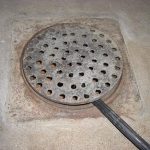If you’re experiencing issues with your wall hung toilet, you’re not alone. In this article, we’ll explore four common problems that may arise and offer solutions to help you fix them.
One of the most important components of your toilet is the flange, which connects the toilet to the drainpipe. It’s crucial to ensure that the flange is installed correctly to prevent damage to your floor, toilet, or drainpipe. In the following sections, we’ll provide a step-by-step guide to replacing or installing a new toilet flange and answer the question of whether or not a toilet flange needs to be screwed to the floor.
What is a Toilet Flange?
A toilet flange, also known as a closet flange, is a crucial component of a toilet’s drainage system. Its primary function is to connect the toilet drain to the home’s drainage system. Additionally, it provides a stable base for the toilet to sit on.
Toilet flanges are available in various materials, including copper, brass, PVC, or steel pipe, and are usually paired with a plastic or metal ring that screws it to the floor.
Toilet flanges come in two sizes, 3 or 4 inches in diameter, and it is essential to choose the size compatible with the drain pipe. Using the wrong size can cause flushing leaks and other problems. Properly securing the toilet flange to the floor is crucial to prevent the toilet from rocking or shifting.
Overall, a toilet flange is a critical component of a toilet’s drainage system, and selecting the right size and securing it correctly is essential for proper toilet function.
Should You Screw Your Toilet Flange to the Floor?
Yes, it is essential to screw your toilet flange to the floor to create a good seal between the flange and the toilet. This will prevent the toilet from shifting and ensure that it remains stable. When installing the toilet flange, make sure that it is bolted to the subfloor or concrete floor and that it is installed properly. The flange height should also be adjusted to match the diameter of the drain pipe.
How to Install a New Toilet Flange?
To install a new toilet flange, you will need the following materials/tools/equipment:
- Toilet flange
- Wax ring
- Screws & bolts
- Cooling oil
- Drill
- Drill bits
- Screwdriver
- PVC primer & glue
- Putty knife
- Toilet flange spacer
- Silicone caulk
Follow these steps for installation:
- Turn off the water supply to the toilet.
- Remove the old wax ring and flange.
- Clean the area around the drain opening and install the new wax ring.
- Install the new flange by attaching it to the drainpipe with screws and bolts.
- Use a level to ensure the flange is even.
- Apply PVC primer and glue to the PVC pipe and flange.
- Attach the toilet flange spacer to the flange.
- Apply silicone caulk around the base of the toilet.
- Place the toilet onto the flange and press down firmly.
- Secure the toilet with screws and bolts.
- Turn on the water supply and check for leaks.
Note: If your flange is too low, you can use a flange extender or shims to raise it. If your flange is too high, you can use an oscillating multi-tool to cut it down. Make sure to use the appropriate replacement flange for your drainpipe (ABS, PVC, cast iron, copper, etc.).
Screw the Toilet Flange to the Floor
After cleaning the surfaces of the drain pipe and the new flange, you need to secure the flange to the floor. The method of securing the flange will depend on the type of floor you have. If the flange is sitting directly on a wooden floor, you will need to screw the flange or flange spacer into the floor with recommended screws. If the flange or flange spacer is sitting on a concrete or tiled floor, you will need to screw the flange/flange spacer to the existing holes using Tapcon screws or any other screws. If there are no existing holes, you will need to drill new holes using your drill. It is important to be careful when using the drill to avoid damaging the drainpipe.
To screw the flange or flange spacer into the floor, you will need a drill, screws, and a screwdriver. The flange bolts, mounting bolts, or closet bolts should be used to secure the flange to the floor. You can also use tapcon screws or any other screws that are recommended for the type of floor you have. Ensure that the screws are long enough to go through the flange and into the floor.
To install the screws, you will need to use an adjustable wrench or a wrench to hold the bolt in place while you use a screwdriver to tighten the screw. You can also use nuts and washers to secure the screws in place. If the screws are too long, you can use a hacksaw to cut them to the desired length.
Once you have secured the flange to the floor, you can put the wax ring in place and attach your toilet to the flange. It is important to ensure that the flange is securely attached to the floor to prevent any leaks.
4 Things to Consider When Securing the Toilet Flange to the Floor
When securing your toilet flange to the floor, there are several things to keep in mind to ensure a safe and leak-free installation. Here are some key considerations:
- Use all pre-drilled holes on the flange to ensure stability and prevent shifting or rocking.
- Select a high-quality flange that will last for an extended period and can handle the weight and pressure of the toilet.
- Ensure that the flange or flange spacer sits directly on the finished floor and does not go below the level of the finished floor to prevent damage and debris from getting trapped.
- Never secure the flange to the floor using epoxy or adhesive, as this can be dangerous and may not provide a watertight seal, leading to leaks and unpleasant odors, including sewer gas.
By following these tips, you can ensure a safe and secure toilet installation that will last for years to come while preventing water damage, dangerous conditions, and unpleasant odors.
Conclusion
In summary, when it comes to installing a new toilet flange, it is important to secure it to the floor using screws or bolts.
While some people may opt to use adhesive or epoxy, this method is not safe and can result in damage to the drainpipe, toilet, or toilet floor.
As a licensed plumber with over 16 years of experience, I highly recommend using screws or bolts to secure your toilet flange to the floor.




